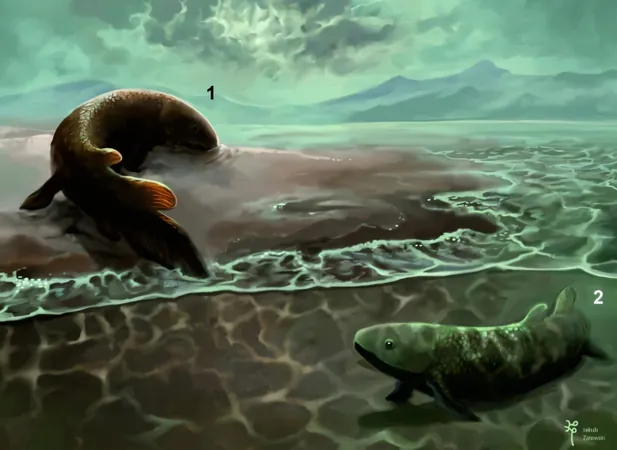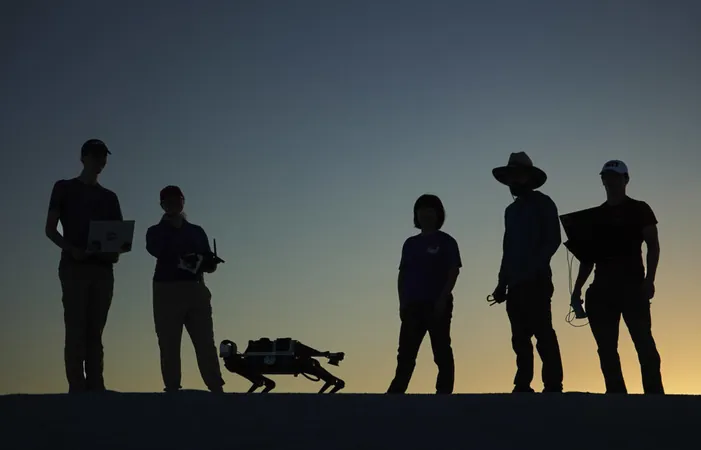
Revolutionary Fish Footprints Reveal Ancient Strides Towards Life on Land!
2025-08-19
Author: Wei Ling
Groundbreaking Discovery in Poland's Geological Tapestry
A stunning revelation from the Polish Geological Institute has unveiled fossilized fish tracks dating back to the Lower Devonian era, approximately 419 to 393 million years ago. Found in the Holy Cross Mountains of Poland, these tracks are attributed to the dipnoan fish, marking an astonishing milestone as the earliest evidence of fish exploring their terrestrial potential—an epic ten million years before fully terrestrial tetrapods took their first steps on land.
A Leap Towards Land: The Quest for New Feeding Grounds
This fascinating adaptation was likely driven by the pursuit of new feeding opportunities during low tide. Although few sites have captured locomotion traces from these pioneering vertebrates, the findings highlight a crucial phase in the evolution of life that would forever change the trajectory of terrestrial ecosystems.
Prehistoric Footprints: A Window to Evolutionary History
Previous to this discovery, the oldest known trackways came from the Middle Devonian in the same region. Interestingly, similar terrestrial traces from this epoch were also identified on Valentia Island, Ireland, indicating that by the dawn of the Middle Devonian, quadrupedal locomotion was already thriving on land. Scientists suggest that we may need to look even further back to fully understand the origins of these terrestrial adaptations.
Delving into the Past: Innovative Research Techniques
In their research, "Traces of dipnoan fish document the earliest adaptations of vertebrates to move on land," published in *Scientific Reports*, scientists meticulously analyzed newly excavated trace fossils using advanced 3D scanning technology. Their work took place in two small, abandoned sandstone quarries, shedding light on the sediment structures that indicate ancient dry land interactions.
The Secrets of Snouts and Strides: Fascinating Features Uncovered
The fossilized imprints reveal unique features of the snouts, resembling those of short-snouted Devonian lungfishes, with distinctive trapezoidal outlines and curved profiles. What’s more, the researchers identified an intriguing pattern: nearly 11% of the traces were leftward twisted, hinting at the possibility of the earliest signs of 'handedness' among vertebrates.
From Water to Land: The Evolutionary Journey Unfolds
Ultimately, this research highlights not only the mobility of these early fish but also their ability to leverage their fins for movement and stability. The findings suggest that some fish rested on their fins, demonstrating complex behavior and interaction with their environment.
A Remarkable Insight into Ancient Life
These extraordinary tracks represent the oldest known evidence of vertebrate locomotion in a semi-terrestrial setting. They illuminate the shared anatomical traits between these dipnoan fish and later tetrapods, showcasing a pivotal chapter in the history of life on Earth.



 Brasil (PT)
Brasil (PT)
 Canada (EN)
Canada (EN)
 Chile (ES)
Chile (ES)
 Česko (CS)
Česko (CS)
 대한민국 (KO)
대한민국 (KO)
 España (ES)
España (ES)
 France (FR)
France (FR)
 Hong Kong (EN)
Hong Kong (EN)
 Italia (IT)
Italia (IT)
 日本 (JA)
日本 (JA)
 Magyarország (HU)
Magyarország (HU)
 Norge (NO)
Norge (NO)
 Polska (PL)
Polska (PL)
 Schweiz (DE)
Schweiz (DE)
 Singapore (EN)
Singapore (EN)
 Sverige (SV)
Sverige (SV)
 Suomi (FI)
Suomi (FI)
 Türkiye (TR)
Türkiye (TR)
 الإمارات العربية المتحدة (AR)
الإمارات العربية المتحدة (AR)